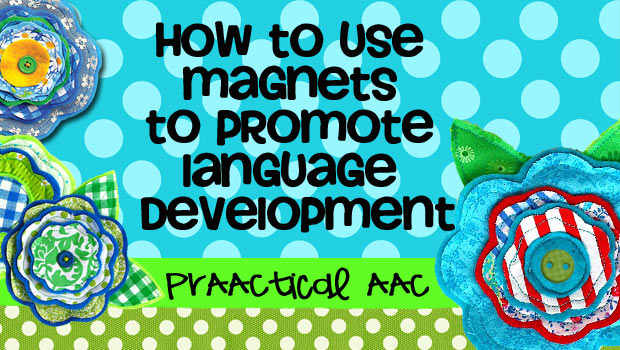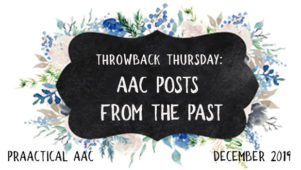How to Use Magnets to Promote Language Development

Want to help AAC learners accelerate their receptive vocabularies? Here’s one quick and easy step in the right direction: Talk to them. We’re not trying to be snarky here. The truth is that we speak less to people who are minimally verbal than we do to people who talk. In general, kids with AAC needs hear far less language than speaking children do. Fewer words heard means fewer opportunities to learn language. That’s a cycle worth breaking.
When we’re around typically developing children, they’re always asking questions. “What’s in the bag, Mom?” “Why is she doing that?” “How come Billy gets to have one and I don’t?” “Where are we going?” “Are we there yet?”
Kids ask lots of questions, particularly in the early years. Annoying? Sometimes. Valuable? Always. From a language learning perspective, those pesky questions serve a very useful purpose: they invite (or demand) a linguistic response. They are magnets that attract language. And that’s just what a language learner needs…lots of language input.
We like to call questions like those ‘language magnets’ because they attract answers. Answers from competent language models (for the most part). Answers with familiar and unfamiliar words. Answers that let them connect less familiar words to the surrounding context. Answers that expand their linguistic horizons.
We can help people who use AAC have this same experience by ensuring that they have adequate access to questions that invite language. The messages can be put on a non-electronic communication aid (like a communication board, PODD book, or eye gaze board), an SGD, or a mobile device with an AAC app. Here are some ideas for “language magnets” to get us started.
Language Magnets
What’s that? What is it?
What’s next? What are you/we going to do?
What’s going on? What happened?
What were you thinking? What made you do that?
Where are they? Where are we going?
When will I see you again? We can we do that?
When is he/she coming?
How did that happen? How does that work?
How come he/she isn’t here?
Who are you? Who was that? Who did it?
Why is he/she here? Why did they do/say that?
Why do I have to do that? Why can’t I?
Why did you do that? Why did that happen?
Why can’t you take me with you?
Tell me about it. Tell me more.
Could you please explain it? (again, some more) Can you explain it another way?
Would you please give me a reason (so I can understand better)?
Can you tell me a story about that?
Can you tell me about it before we start?
Can you tell me about what we just did?
Filed under: PrAACtical Thinking
Tagged With: intervention, language magnets, messages, questions, SGD, vocabulary, word learning
This post was written by Carole Zangari





3 Comments
I love this post. I recently added some questions onto my son’s device so that he could participate more easily during meal time discussions. He is now the one that asks the questions e.g. Who did you see today? What was your favourite part of the day? etc.
He uses a Vantage Lite and would have to build the question sentences himself otherwise. What might be a good way to adapt his device so that he can have more ‘quick’ hit questions? Would you suggest adding a questions page to his device?
Thanks!
Yay for your little man!!! It’s so great to hear about those successes! It’s a little hard to answer specific questions without knowing the kid and situation, but I generally approach things like that by asking myself about priorities. e.g., What’s the most important thing I want to achieve with this? If it is something like increasing the frequency of asking questions in conversational contexts, for example, then I might pre program some questions. But if I am prioritizing the learning of a specific syntactic form or working on morphological endings, for example, then I probably would not prestore whole questions. Hope that helps. Thanks for the comment, Stacey!
Thank you again for sharing all your wisdom! I appreciate you answering my question to the best of your ability.